The drive from the Coromandel to Rotorua took us along the coast, encountering some really beautiful scenery. From Tauranga we headed inland and directly towards Rotorua. The landscape had changed from closely packed mountains to a much wider, more open landscape. There were fewer trees and more parched grasslands with volcanic cones rising out of the plains.
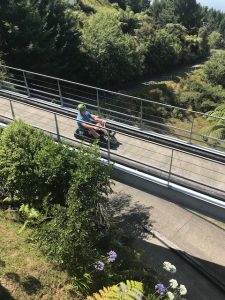 Our first destination in Rotorua was the Skyline Park for a bit of boyish fun. The girls were free to follow us but they chose to watch, to drink coffee, eat ice cream and tut! A gondola took us up to a high vantage point with panoramic views over the whole of Rotorua and the lake, once part of a massive volcanic system. John and I had booked three runs on the luge, a low, four-wheeled vehicle, not dissimilar to a go-kart. A joy stick between our legs allowed us to steer and to brake. I was amazed how quiet it was. Last year the queues were quite long but there was hardly anybody on the track. We took the intermediate course for the first run, but after that we were both up for the more technical and faster advanced route. Great fun, especially where you take off going over a sudden steep dip.
Our first destination in Rotorua was the Skyline Park for a bit of boyish fun. The girls were free to follow us but they chose to watch, to drink coffee, eat ice cream and tut! A gondola took us up to a high vantage point with panoramic views over the whole of Rotorua and the lake, once part of a massive volcanic system. John and I had booked three runs on the luge, a low, four-wheeled vehicle, not dissimilar to a go-kart. A joy stick between our legs allowed us to steer and to brake. I was amazed how quiet it was. Last year the queues were quite long but there was hardly anybody on the track. We took the intermediate course for the first run, but after that we were both up for the more technical and faster advanced route. Great fun, especially where you take off going over a sudden steep dip.
Our accommodation for the night was the modern Rotorua YHA, not just catering for backpackers but also providing basic, but good, en-suite rooms. We just had time to get ourselves sorted and we were out again to the Mitai Maori Village cultural evening and hangi.
On arrival we were ushered into a permanent tented dining room with about 200 other people. Our host introduced himself to the assembled room and then sought to find out where people had come from. It turned out that there were well over twenty different nationalities represented and he was able to greet them all in their own language, except one; there were four chaps from Uzbekistan, the first in his experience as a host and good reason for him not to know the language. Chocolate cake, which featured a lot in his banter, is easy to understand whatever the language. Everybody saw the humour in that.
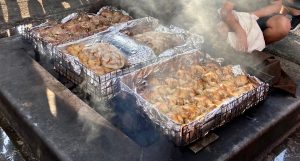 Introductions over, we ventured into the jungle and congregated by a stream. Before doing so, we had to inspect the hangi being opened up to reveal numerous cooked chickens, large joints of lamb, potatoes, kumara (NZ sweet potatoes) and vegetables etc., the basis of the meal to come. In the jungle we could hear the war cry of approaching Maori. As we gathered by the stream a waka (Maori canoe) came into view, carrying a number of Maori warriors of different shapes and sizes. As they passed they gave us the bulging eye stare and the waggling tongue.
Introductions over, we ventured into the jungle and congregated by a stream. Before doing so, we had to inspect the hangi being opened up to reveal numerous cooked chickens, large joints of lamb, potatoes, kumara (NZ sweet potatoes) and vegetables etc., the basis of the meal to come. In the jungle we could hear the war cry of approaching Maori. As we gathered by the stream a waka (Maori canoe) came into view, carrying a number of Maori warriors of different shapes and sizes. As they passed they gave us the bulging eye stare and the waggling tongue.
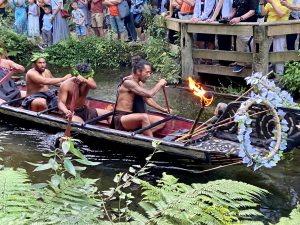 Once they were ashore, we moved on to a theatre where the stage was the jungle with typical Maori houses built amongst the trees. We were then entertained to a historical show demonstrating Maori singing, musical instruments, weapons and the inevitable hacka. It was all very well done. Most of the audience appreciated it but we had a Korean in front of us who spent all of his time on his phone looking at websites, talking loudly with his children sitting next to him and taking no notice at all of what was happening in front of him.
Once they were ashore, we moved on to a theatre where the stage was the jungle with typical Maori houses built amongst the trees. We were then entertained to a historical show demonstrating Maori singing, musical instruments, weapons and the inevitable hacka. It was all very well done. Most of the audience appreciated it but we had a Korean in front of us who spent all of his time on his phone looking at websites, talking loudly with his children sitting next to him and taking no notice at all of what was happening in front of him.
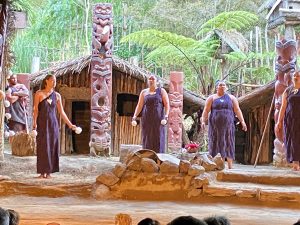 Once the show was over, we returned to our dining tent and enjoyed a really good meal. There were four stations where the food was laid out for you to help yourself. The meal included a starter of seafood chowder, the main course was all of the things I have already mentioned and the dessert, believe it or not, was chocolate cake. It was interesting to see how people behaved in such a situation. Many didn’t bother with the chowder, which I think was the best part of the meal. By the time I came to get the main course, much of it had gone. People had piled their plates high with as much as they possible could. There was enough to go around but there were elements of the evening which were obscene, particularly when so many decided to leave as soon as they had eaten. I felt sorry for those who had done so much work to make the evening an enjoyable success, but the lack of respect for Maori culture, the rudeness of some at the dinner table disappointed me, making me question whether I would do it again.
Once the show was over, we returned to our dining tent and enjoyed a really good meal. There were four stations where the food was laid out for you to help yourself. The meal included a starter of seafood chowder, the main course was all of the things I have already mentioned and the dessert, believe it or not, was chocolate cake. It was interesting to see how people behaved in such a situation. Many didn’t bother with the chowder, which I think was the best part of the meal. By the time I came to get the main course, much of it had gone. People had piled their plates high with as much as they possible could. There was enough to go around but there were elements of the evening which were obscene, particularly when so many decided to leave as soon as they had eaten. I felt sorry for those who had done so much work to make the evening an enjoyable success, but the lack of respect for Maori culture, the rudeness of some at the dinner table disappointed me, making me question whether I would do it again.
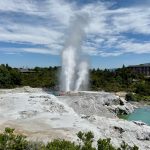
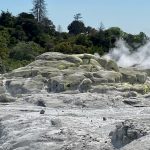
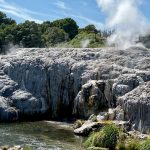
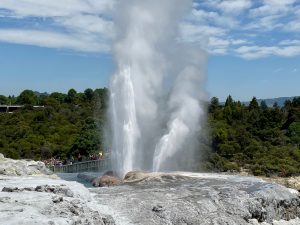 Before we left Rotorua we visited the thermal park at Whakarewarewa, where the star attraction is the Pohutu Geyser that erupts every forty-five minutes or so. It was spouting forth just as we arrived and we watched it from across the park. This gave us plenty of time to see some of the other attractions, including the kiwi kept in captivity. The kiwi house is in almost total blackout and noise must be kept to a minimum. When I have been there before I have failed to see the kiwi. This time it was rooting around next to the glass and it was vaguely visible. We were then able to amble across to Pohutu and wait for its next eruption. Steam is constantly rising and small jets of water get pushed above the surface. Sometimes these small jets become bigger and everybody gets excited as they think it is about to go. Then is subsides again, so we wait some more. Eventually, as predicted, it goes off on time and it is well worth waiting for. There are two plumes of water and steam, rising about 25 metres, and they last for several minutes before it all calms down again and begins to prepare for its next eruption.
Before we left Rotorua we visited the thermal park at Whakarewarewa, where the star attraction is the Pohutu Geyser that erupts every forty-five minutes or so. It was spouting forth just as we arrived and we watched it from across the park. This gave us plenty of time to see some of the other attractions, including the kiwi kept in captivity. The kiwi house is in almost total blackout and noise must be kept to a minimum. When I have been there before I have failed to see the kiwi. This time it was rooting around next to the glass and it was vaguely visible. We were then able to amble across to Pohutu and wait for its next eruption. Steam is constantly rising and small jets of water get pushed above the surface. Sometimes these small jets become bigger and everybody gets excited as they think it is about to go. Then is subsides again, so we wait some more. Eventually, as predicted, it goes off on time and it is well worth waiting for. There are two plumes of water and steam, rising about 25 metres, and they last for several minutes before it all calms down again and begins to prepare for its next eruption.
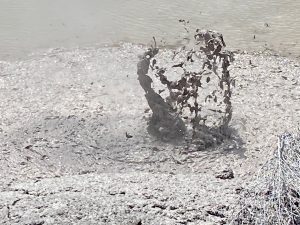 From Whakarewarewa, we went to Wai O Tapu, another thermal park en route to Taupo. Just before we went into the park we took a short detour to see some bubbling mud pools. The sound of gloopy mud and the shapes they create never cease to fascinate.
From Whakarewarewa, we went to Wai O Tapu, another thermal park en route to Taupo. Just before we went into the park we took a short detour to see some bubbling mud pools. The sound of gloopy mud and the shapes they create never cease to fascinate.
Wai O Tapu is a much larger thermal park and has many more features ranging from collapsed fumaroles, moonscapes, and fluorescent lakes of varying colours. It is part of a massive caldera that formed during a particularly active period in its history. There are clearly marked paths around the site with instruction not to deviate into anything that might be hot. The lakes are particularly impressive for their startling colours of blue with copper edges, sulphurous green and yellow. They have wonderful names like Champagne Pool, Artist’s Palette but the most bizarre is the last lake we came across, which is lurid green/yellow but has no name.
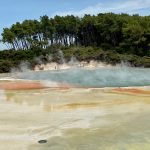
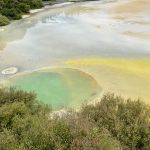
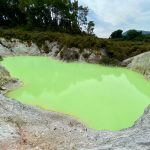
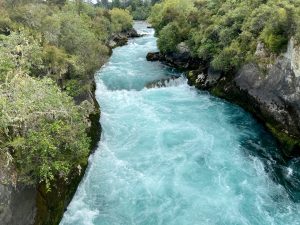 Having absorbed everything thermal, we continued our journey, stopping off at the impressive Huka Falls just before reaching Taupo. Having said they were impressive, they were not as impressive as I have seen them in the past. Much of North Island has seen little rain all summer and the water level in the falls was much lower. Hula Falls is probably a misnomer. It is principally a water shoot, where the Waikato River, recently emerged from Lake Taupo, is forced through a narrow gap punctuated by a number of small waterfalls. It is the force of the water passing through the gap that makes it so impressive.
Having absorbed everything thermal, we continued our journey, stopping off at the impressive Huka Falls just before reaching Taupo. Having said they were impressive, they were not as impressive as I have seen them in the past. Much of North Island has seen little rain all summer and the water level in the falls was much lower. Hula Falls is probably a misnomer. It is principally a water shoot, where the Waikato River, recently emerged from Lake Taupo, is forced through a narrow gap punctuated by a number of small waterfalls. It is the force of the water passing through the gap that makes it so impressive.
We bypassed the town of Taupo but it took us some time to work our way around Lake Taupo. It is huge, the largest lake in New Zealand with an area of over 600sq.km.
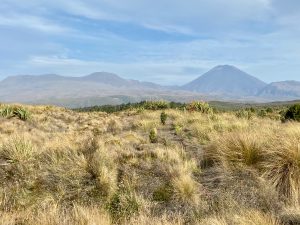 Leaving the lake, the journey took us into the magical volcanic scenery of the Tongariro National Park, an area we were going to explore further on foot. Needless to say the views of Mt. Ngauruhoe (Mt. Doom) and Mt. Ruapehu were stunning and provided us with a welcome change from all the coastal scenery we had experienced so far.
Leaving the lake, the journey took us into the magical volcanic scenery of the Tongariro National Park, an area we were going to explore further on foot. Needless to say the views of Mt. Ngauruhoe (Mt. Doom) and Mt. Ruapehu were stunning and provided us with a welcome change from all the coastal scenery we had experienced so far.
The Youth Hostel at National Park had somehow messed up our booking and only had us down for one room. Had they been full we might have had a problem but the English girl on reception managed the situation extremely well and we all managed to get what we wanted. She also managed well the fact that our plan to walk the Tongariro Crossing the next day was not possible because of high winds – the route was closed. It would be a shame to come all this way and not be able to do, what can best be described as, one of the best day walks in the world. We decided we would find something else to do on the day the route was closed and, hopefully do it the following day, which had a much more promising forecast, before driving to Napier.
That night we ate in the Schnapps Bar, a really well run bar with a good menu.
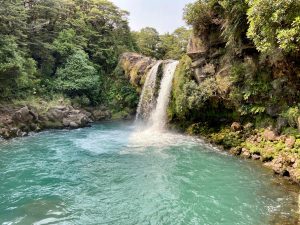 There may have been wind at higher altitudes but it was a lovely day at lower levels, which we decided to explore further. We decided to go to Whakapapa Village to walk the Taranaki Falls Loop Track, but on the way we stopped off to take a short walk to Tawhai Falls, a 13m fall on the Whakapapanui Stream.
There may have been wind at higher altitudes but it was a lovely day at lower levels, which we decided to explore further. We decided to go to Whakapapa Village to walk the Taranaki Falls Loop Track, but on the way we stopped off to take a short walk to Tawhai Falls, a 13m fall on the Whakapapanui Stream.
Before walking the loop track we spent some time in the visitor centre in Whakapapa, which has really interesting displays and a captivating film on the geography/geology of the park. Whakapapa is also where you can find Chateau Tongariro, a large hotel, totally out of character with its surroundings. Nevertheless, it was the perfect place for coffee, sitting in a picture window looking out towards the mountains.
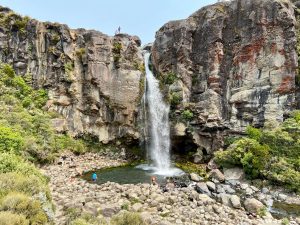 The Taranaki Falls, at the halfway point of the loop, are an impressive 20m drop over the edge of an lava flow. A good spot for a picnic and a chance to explore around the back of the falls. It was difficult to appreciate how windy it was near the summits, as the sky was cloudless, giving us nothing to gauge speed with. The little jaunt we had to make up for not doing the crossing, enabled us to stretch our legs a little while exploring the area.
The Taranaki Falls, at the halfway point of the loop, are an impressive 20m drop over the edge of an lava flow. A good spot for a picnic and a chance to explore around the back of the falls. It was difficult to appreciate how windy it was near the summits, as the sky was cloudless, giving us nothing to gauge speed with. The little jaunt we had to make up for not doing the crossing, enabled us to stretch our legs a little while exploring the area.
The following morning, John, Chris and I were up early to catch the 6.00am bus to the start point of the Tongariro Crossing at Mangatepopo Road End. Apart from a little cloud hanging around Mt. Ngauruhoe, the skies were clear.
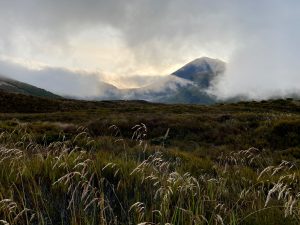 Soon after 6.30 we were walking the easy first section of the walk across relatively flat heathland. As we did so the few clouds that were hanging around the summits soon burnt off. There were a lot of people walking the route. It is always very popular in the summer months, but, perhaps more so because the route was closed the day before. After an hour we began the first climb. Looking back, as we took a rest, we could see Mt.Taranaki poking out above cloud, probably 120km to the west. As we reached the top of the climb and emerged into a flat, former, crater directly beneath the perfect cone of Mt. Ngauruhoe. It was really exciting to be walking among such dramatic volcanic scenery.
Soon after 6.30 we were walking the easy first section of the walk across relatively flat heathland. As we did so the few clouds that were hanging around the summits soon burnt off. There were a lot of people walking the route. It is always very popular in the summer months, but, perhaps more so because the route was closed the day before. After an hour we began the first climb. Looking back, as we took a rest, we could see Mt.Taranaki poking out above cloud, probably 120km to the west. As we reached the top of the climb and emerged into a flat, former, crater directly beneath the perfect cone of Mt. Ngauruhoe. It was really exciting to be walking among such dramatic volcanic scenery.
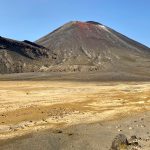
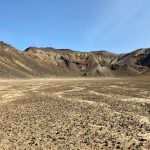
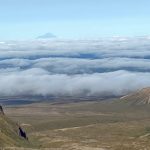 The second climb brought us to the edge of the Red Crater, the high point of the walk. Unbelievably, it was still quite windy with gusts in excess of 50kmph, strong enough for you to approach the edge with care.
The second climb brought us to the edge of the Red Crater, the high point of the walk. Unbelievably, it was still quite windy with gusts in excess of 50kmph, strong enough for you to approach the edge with care.
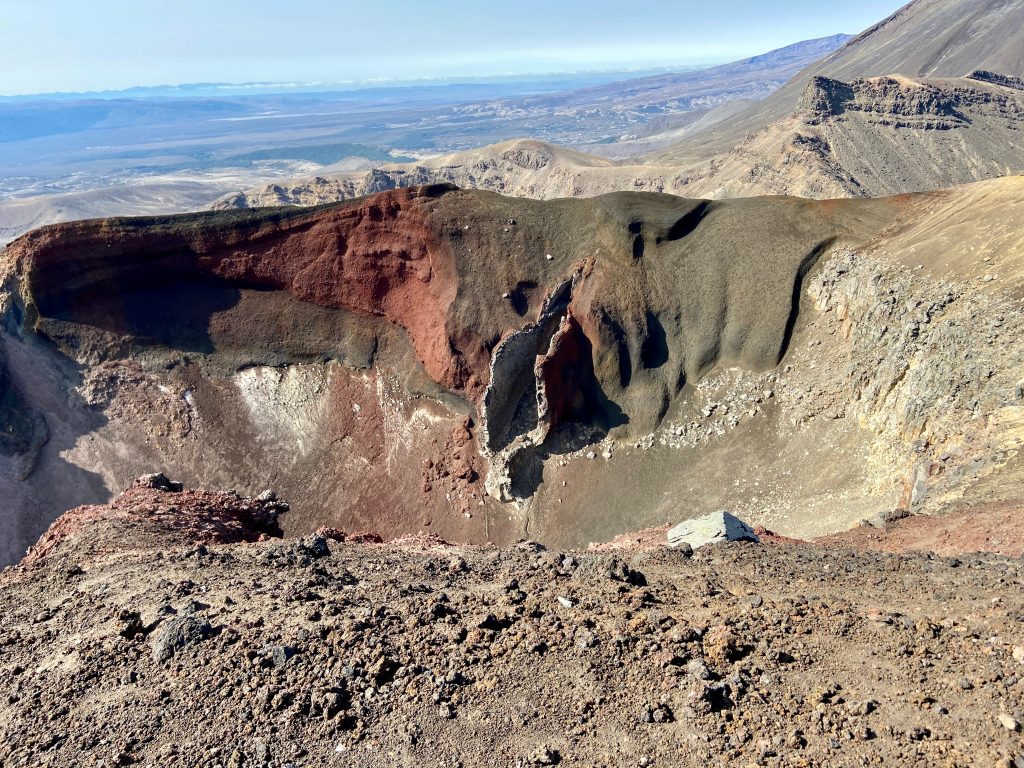 The Red Crater is spectacular in the extreme. In the centre of the crater is the most incredible vent, that at one time spewed out masses of volcanic material. The route now descended steeply down very loose scree at the edge of the crater. Very few, only the really sure footed, can travel down this slope quickly. Most place each foot tentatively, uncertain whether the ground beneath their feet will hold or send them sprawling. This brought us to the Emerald Lake. Beyond, fumaroles gently puffed out steam.
The Red Crater is spectacular in the extreme. In the centre of the crater is the most incredible vent, that at one time spewed out masses of volcanic material. The route now descended steeply down very loose scree at the edge of the crater. Very few, only the really sure footed, can travel down this slope quickly. Most place each foot tentatively, uncertain whether the ground beneath their feet will hold or send them sprawling. This brought us to the Emerald Lake. Beyond, fumaroles gently puffed out steam.
 We were now about half way and we had done all of the climbing, apart from a small rise up to the Blue Lake. Now it really was downhill all the way. The first half of the walk had
We were now about half way and we had done all of the climbing, apart from a small rise up to the Blue Lake. Now it really was downhill all the way. The first half of the walk had 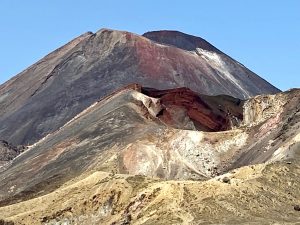 been varied with lots of interest all along the way. Now, there were few features and it became a bit of a downhill slog, with lots of steps taking their toll on our knees. John, with old injuries to his Achilles, was struggling. Chris found some of the steps down difficult, and the really excited mood of the ascent was replaced with grimaces of pain and questions about how much further. Having announced that there were fewer steps, I was proved wrong as the number of steps increased significantly. I have done this walk a couple times before, so there should be no excuses for me getting it wrong. I can only assume that selective memory has blotted out the steps and I only remember the good bits. Sorry guys!
been varied with lots of interest all along the way. Now, there were few features and it became a bit of a downhill slog, with lots of steps taking their toll on our knees. John, with old injuries to his Achilles, was struggling. Chris found some of the steps down difficult, and the really excited mood of the ascent was replaced with grimaces of pain and questions about how much further. Having announced that there were fewer steps, I was proved wrong as the number of steps increased significantly. I have done this walk a couple times before, so there should be no excuses for me getting it wrong. I can only assume that selective memory has blotted out the steps and I only remember the good bits. Sorry guys!
 About half a mile before the end, I got my comeuppance, stepping off a bridge, I painfully rolled my ankle. Serves me right.
About half a mile before the end, I got my comeuppance, stepping off a bridge, I painfully rolled my ankle. Serves me right.
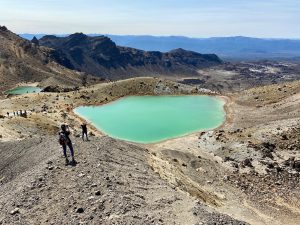 At the finish, Angela and Chrissie were there to meet us. They had spent the day in Turangi, where they had learnt everything there is to know about trout fishing. We thankfully piled into the vehicle and headed off to Napier, sharing tales of our day. While the downhill section is arduous and a strain on the knees, the Tongariro Crossing is one of the world’s great one-day walks and I would not hesitate to do it again and again.
At the finish, Angela and Chrissie were there to meet us. They had spent the day in Turangi, where they had learnt everything there is to know about trout fishing. We thankfully piled into the vehicle and headed off to Napier, sharing tales of our day. While the downhill section is arduous and a strain on the knees, the Tongariro Crossing is one of the world’s great one-day walks and I would not hesitate to do it again and again.
The outcome of the Tongariro Crossing was that John and Chris felt that it might be too much to consider doing the Routeburn Track, in the light of how they felt after this walk. Without escape routes, it might prove difficult if John’s Achilles chose to play up. Little did we know then that the weather on South Island was going to intervene and make the decision for us.

